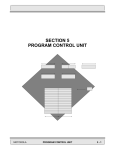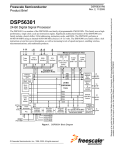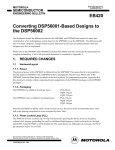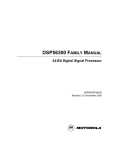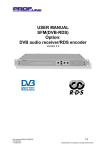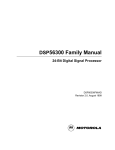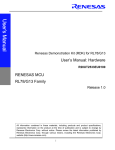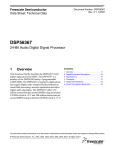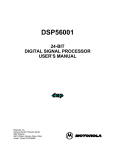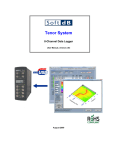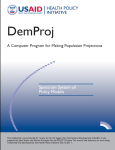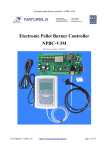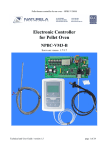Download F re e s c a le S e m ic o n d u c to r, I n c . ..
Transcript
Freescale Semiconductor, Inc. SECTION 3 MEMORY SPACES Freescale Semiconductor, Inc... This section is divided into two major subsections, the DSP56000 and DSP56001. Each subsection describes the memory spaces available and the operating modes that redefine these memory spaces. 3.1 OVERVIEW The memory of the DSP56000/DSP56001 can be partitioned in several ways to provide high-speed parallel operation and additional off-chip memory expansion. Program and data memory are separate, and the data memory is, in turn, divided into two separate memory spaces, X and Y. Both the program and data memories can be expanded offchip. There are also two on-chip data read-only memories (ROMs) that can overlay a portion of the X and Y data memories and a bootstrap ROM (DSP56001 only) that can overlay part of the program random-access memory (RAM). The data memories are divided into two independent spaces to work with the two address arithmetic logic units (ALUs) to feed two operands simultaneously to the data ALU. 3.2 DSP56000 MEMORY INTRODUCTION The three independent memory spaces of the DSP56001, X data, Y data, and program, are shown in Figure 3-1. The memory spaces are configured by control bits in the operating mode register (OMR). The operating mode control bits (MA and MB) in the OMR control the program memory map and select the reset vector address. The data ROM enable (DE) bit in the OMR controls the X and Y data memory maps and enables/disables the internal X and Y data ROMs. The bootstrap memory on the DSP56000 is used only for factory testing and should not be invoked by the user. 3.2.1 X Data Memory The on-chip X data RAM is a 24-bit-wide, internal, static memory occupying the lowest 256 locations (0–255) in X memory space. The on-chip X data ROM (factory programmed to user specifications like the program ROM) occupies locations 256–511 in the X data memory space and is controlled by the DE bit in the OMR. The on-chip peripheral registers occupy the top 64 locations of the X data memory ($FFC0–$FFFF). The 16-bit addresses are received from the XAB, and 24-bit data transfers to the data ALU occur on the XDB. The X memory may be expanded to 64K off-chip. MOTOROLA DSP56000/DSP56001 USER’S MANUAL For More Information On This Product, Go to: www.freescale.com 3-1 Freescale Semiconductor, Inc. $FFFF $FFFF $FFFF PROGRAM MEMORY SPACE X DATA MEMORY SPACE Y DATA MEMORY SPACE $3F INTERRUPT VECTORS Freescale Semiconductor, Inc... $0 $0 $0 OPERATING MODE DETERMINES PROGRAM MEMORY AND RESET STARTING ADDRESS MODE 0 MB = 0 MA = 0 $E000 EXTERNAL $EFF DE = 1 $FFFF ON-CHIP $EFC0 PERIPHERALS $FFFF RESET EXTERNAL EXTERNAL $EFF INTERNAL ROM $0 MODE 3 MB = 1 MA = 1 MODE 2 MB = 1 MA = 0 $FFFF $FFFF DE BIT IN THE OMR DETERMINES THE X AND Y DATA MEMORY MAPS RESET INTERNAL ROM INTERNAL RESET INTERNAL ROM RESET $0 $0 INTERNAL ROM EXTERNAL RESET NO INTERNAL ROM EXTERNAL RESET EXTERNAL PERIPHERALS EXTERNAL X DATA MEMORY EXTERNAL Y DATA MEMORY $1FF INTERNAL X ROM INTERNAL Y ROM $0FF INTERNAL X RAM $0 INTERNAL Y RAM DE = 0 $FFFF ON-CHIP $FFC0 PERIPHERALS DATA ROMS ENABLED EXTERNAL PERIPHERALS EXTERNAL X DATA MEMORY EXTERNAL Y DATA MEMORY $0FF INTERNAL X RAM $0 INTERNAL Y RAM DATA ROMS DISABLED Figure 3-1 DSP56000 Memory Map 3.2.2 Y Data Memory The on-chip Y data RAM is a 24-bit-wide, internal, static memory occupying the lowest 256 locations (0–255) in the Y memory space. The on-chip Y data ROM (factory programmed to user specifications like the program ROM) occupies locations 256–511 in Y data memory space and is controlled by the DE bit in the OMR. The off-chip peripheral registers should be mapped into the top 64 locations ($FFC0–$FFFF) to take advantage of the move peripheral data (MOVEP) instruction. The 16-bit addresses are received from the YAB, and 24-bit data transfers to the data ALU occur on the YDB. Y memory may be 3-2 DSP56000/DSP56001 USER’S MANUAL For More Information On This Product, Go to: www.freescale.com MOTOROLA Freescale Semiconductor, Inc. expanded to 64K off-chip. 3.2.3 Program Memory On-chip program memory consists of a 3840-location by 24-bit, high-speed ROM (3.75K x 24) that is enabled/disabled by the MA and MB bits in the OMR. When the on-chip program memory is disabled, either off-chip memory or a special mode 1 ROM is selected for program memory. Freescale Semiconductor, Inc... NOTE: The mode 1 ROM is used only for test purposes on the DSP56000 and should not be invoked by the user. Addresses are received from the program control logic (usually the program counter) over the PAB. Off-chip program memory may be written using move program memory (MOVEM) instructions. The interrupt vectors for the on-chip resources are located in the bottom 64 locations ($0000–$003F) of program memory. Program memory may be expanded to 64K off-chip. 3.2.4 Chip Operating Modes The DSP operating modes determine the memory maps for program and data memories and the startup procedure when the DSP leaves the reset state. The MODA and MODB pins are sampled as the DSP leaves the reset state, and the initial operating mode of the DSP is set accordingly. When the reset state is exited, the MODA and MODB pins become general-purpose interrupt pins, IRQA and IRQB. One of three initial operating modes is selected: single chip, normal expanded, or development. Chip operating modes can be changed by writing the operating mode bits (MB, MA) in the OMR. Changing operating modes does not reset the DSP. It is desirable to disable interrupts immediately before changing the OMR to prevent an interrupt from going to the wrong memory location. Also, one no-operation (NOP) instruction should be included after changing the OMR to allow for remapping to occur. Some pins on the DSP are mode independent; whereas, the use of others depends on the particular operating mode. Specifically, external address bus, data bus, and bus conTable 3-1 Initial DSP56000 Operating Mode Summary MOTOROLA Operating Mode MOD B MODA 0 0 0 Single-Chip Mode 1 0 1 Single-Chip Mode 2 1 0 Normal Expanded Mode 3 1 1 Development Mode Description DSP56000/DSP56001 USER’S MANUAL For More Information On This Product, Go to: www.freescale.com 3-3 Freescale Semiconductor, Inc. trol pins are affected by the particular operating mode. Table 3-1 shows the mode assignments. 3.2.4.1 Single-Chip Mode (Mode 0). In the single-chip mode, all internal program and data Freescale Semiconductor, Inc... RAM memories are enabled. A hardware reset causes the DSP to jump to internal program memory location $0000 ($=hexadecimal notation) and resume execution. The memory map for this mode is shown in Figure 3-2. The memory maps for mode 0 and mode 2 (see Figure 3-3) are identical. The difference between the two modes is that reset vectors to program memory location $0000 in mode 0 and vectors to location $E000 in mode 2. PROGRAM MEMORY SPACE $FFFF X DATA MEMORY SPACE $FFFF $FFC0 $FFBF EXTERNAL PROGRAM MEMORY $FFFF ON-CHIP PERIPHERALS INTERNAL PROGRAM ROM $01FF $003F INTERRUPTS $00FF $0000 RESET $0000 USER-DEFINED ROM INTERNAL X RAM EXTERNAL Y DATA MEMORY $01FF DE=1 USER-DEFINED ROM $00FF $0000 INTERNAL Y RAM ON-CHIP PERIPHERAL MAP INTERRUPT MAP $0000 $FFC0 EXTERNAL PERIPHERALS EXTERNAL X DATA MEMORY $0EFF $007F $0040 $003E $003C $003A $0024 Y DATA MEMORY SPACE $FFFF HOST COMMANDS INTERRUPT PRIORITY BUS CONTROL SCI INTERFACE SSI INTERFACE HOST INTERFACE PARALLEL I/0 INTERFACE ILLEGAL INSTRUCTION INT. TIMER INTERRUPT HOST COMMANDS SCI INTERRUPTS SSI INTERRUPTS EXTERNAL INTERRUPTS SWI INTERRUPT TRACE INTERRUPT STACK ERROR INTERRUPT RESET $FFE0 RESERVED $FFC0 NOTE: Addresses $FFC0–$FFFF in X data memory are NOT available externally. Figure 3-2 Memory Map for DSP56000 Mode 0: Single-Chip Mode 3.2.4.2 Mode 1. Mode 1 is the same as Mode 0 on the DSP56000. It is recommended that 3-4 DSP56000/DSP56001 USER’S MANUAL For More Information On This Product, Go to: www.freescale.com MOTOROLA Freescale Semiconductor, Inc. PROGRAM MEMORY SPACE $FFFF $E000 X DATA MEMORY SPACE $FFFF $FFC0 $FFBF RESET Freescale Semiconductor, Inc... $003F $0000 INTERNAL PROGRAM ROM $FFFF ON-CHIP PERIPHERALS $01FF $017F $00FF INTERRUPTS $0000 USER-DEFINED ROM INTERNAL X RAM $0000 HOST COMMANDS EXTERNAL Y DATA MEMORY $01FF DE=1 $00FF $0000 USER-DEFINED ROM INTERNAL Y RAM $FFFF INTERRUPT PRIORITY BUS CONTROL SCI INTERFACE SSI INTERFACE HOST INTERFACE PARALLEL I/0 INTERFACE ILLEGAL INSTRUCTION INT. TIMER INTERRUPT HOST COMMANDS SCI INTERRUPTS SSI INTERRUPTS EXTERNAL INTERRUPTS SWI INTERRUPT TRACE INTERRUPT STACK ERROR INTERRUPT RESET EXTERNAL PERIPHERALS ON-CHIP PERIPHERAL MAP INTERRUPT MAP $007F $0040 $003E $003C $003A $0024 $FFC0 $FFBF EXTERNAL X DATA MEMORY EXTERNAL PROGRAM MEMORY $0EFF Y DATA MEMORY SPACE $FFE0 RESERVED $FFC0 NOTE: Addresses $FFC0–$FFFF in X data memory are NOT available externally. Figure 3-3 Memory Map for DSP56000 Mode 2: Normal Expanded Mode this mode not be invoked by the user. 3.2.4.3 Normal Expanded Mode (Mode 2). Mode 2 is almost identical to mode 0 (see 3.2.4.1 Single-Chip Mode (Mode 0). In the single-chip mode, all internal program and data RAM memories are enabled. A hardware reset causes the DSP to jump to internal program memory location $0000 ($=hexadecimal notation) and resume execution. The memory map for this mode is shown in Figure 3-2. The memory maps for mode 0 and mode 2 (see Figure 3-3) are identical. The difference between the two modes is that reset vectors to program memory location $0000 in mode 0 and vectors to location $E000 in mode 2. for further information). 3.2.4.4 Development Mode (Mode 3). The development mode is similar to the normal expanded mode except that internal program memory is disabled. All references to program memory space are directed to external program memory, which is accessed on the external data bus. The memory map for this mode is shown in Figure 3-4. DSP56000 chips with bad MOTOROLA DSP56000/DSP56001 USER’S MANUAL For More Information On This Product, Go to: www.freescale.com 3-5 Freescale Semiconductor, Inc. PROGRAM MEMORY SPACE $FFFF X DATA MEMORY SPACE $FFFF $FFC0 $FFBF EXTERNAL PROGRAM MEMORY Y DATA MEMORY SPACE $FFFF ON-CHIP PERIPHERALS $FFC0 $FFBF EXTERNAL PERIPHERALS EXTERNAL X DATA MEMORY EXTERNAL Y DATA MEMORY $01FF Freescale Semiconductor, Inc... DE=0 $003F INTERRUPTS $00FF $0000 RESET $0000 INTERNAL X RAM $0000 $0000 INTERNAL Y RAM ON-CHIP PERIPHERAL MAP INTERRUPT MAP $007F $0040 $003E $003C $003A $0024 $00FF $FFFF HOST COMMANDS INTERRUPT PRIORITY BUS CONTROL SCI INTERFACE SSI INTERFACE HOST INTERFACE PARALLEL I/0 INTERFACE ILLEGAL INSTRUCTION INT. TIMER INTERRUPT HOST COMMANDS SCI INTERRUPTS SSI INTERRUPTS EXTERNAL INTERRUPTS SWI INTERRUPT TRACE INTERRUPT STACK ERROR INTERRUPT RESET $FFE0 RESERVED $FFC0 NOTE: Addresses $FFC0–$FFFF in X data memory are NOT available externally. Figure 3-4 Memory Map for DSP56000 Mode 3: Development Mode or obsolete internal program ROM code can be used with external program memory in the development mode. The memory map in Figure 3-4is shown with DE arbitrarily set to zero. 3.2.5 Security ROM Version (DSP56000)1 The security ROM version of the DSP56000 is a standard DSP56000 that has been modified to prevent unauthorized access to the program contained in the DSP program ROM. This protection is accomplished in two ways. First, the DSP is forced into the single-chip mode at reset. The chip powers up in single-chip mode, and it is not possible to enter any other mode on powerup. The MODA/IRQA and MODB/IRQB pins are configured only as IRQA and IRQB and cannot be used to change the mode. Second, the programmer must avoid fetches from external program memory =m i.e., the user code must be placed only in internal 1. For additional information concerning this part, contact the Motorola field office. 3-6 DSP56000/DSP56001 USER’S MANUAL For More Information On This Product, Go to: www.freescale.com MOTOROLA Freescale Semiconductor, Inc. program ROM. This placement prevents the execution of unauthorized code that might be used to dump the contents of the program ROM. 3.3 DSP56001 MEMORY INTRODUCTION Freescale Semiconductor, Inc... The three independent memory spaces of the DSP56001, X data, Y data, and program, are shown in Figure 3-5. The memory spaces are configured by control bits in the OMR. The MA and MB control bits in the OMR control the program memory map and select the reset vector address. The DE bit in the OMR controls the X and Y data memory maps and enables/disables the internal X and Y data ROMs. One additional memory available on the DSP56001 is the bootstrap memory that overlays the program memory in mode 1. 3.3.1 X Data Memory The on-chip X data RAM is a 24-bit-wide, static, internal memory occupying the lowest 256 locations (0–255) in X memory space. The on-chip X data ROM occupies locations 256–511 in the X data memory space when enabled by setting DE to one in the OMR. The X data ROM is factory programmed with positive Mu-law and A-law expansion tables, which are useful in telecommunication applications. The on-chip peripheral registers occupy the top 64 locations of the X data memory (locations $FFC0–$FFFF). The 16-bit addresses are received from the XAB, and 24-bit data transfers to the data ALU occur on the XDB. The X memory may be expanded to 64K off-chip. 3.3.2 Y Data Memory The on-chip Y data RAM is a 24-bit-wide, static, internal memory occupying the lowest 256 locations (0–255) in the Y memory space. The on-chip Y data ROM occupies locations 256–511 in Y data memory space when enabled by setting DE to one in the OMR. The Y data ROM is factory programmed with a full, four-quadrant, sine-wave table (see DSP56001 Advance Information Data Sheet(ADI1290)), which is useful for fast Fourier transforms, discrete Fourier transforms, and waveform generation. The off-chip peripheral registers should be mapped into the top 64 locations ($FFC0– $FFFF) to take advantage of the MOVEP instruction. The 16-bit addresses are received from the YAB, and 24-bit data transfers to the data ALU occur on the YDB. Y memory may be expanded to 64K off-chip. 3.3.3 Program Memory On-chip program memory consists of a 512-location by 24-bit, high-speed, static RAM that is enabled/disabled by the MA and MB bits in the OMR. When the on-chip program memory is disabled, either off-chip memory or a special bootstrap ROM is selected for program memory. MOTOROLA DSP56000/DSP56001 USER’S MANUAL For More Information On This Product, Go to: www.freescale.com 3-7 Freescale Semiconductor, Inc. $FFFF $FFFF $FFFF PROGRAM MEMORY SPACE X DATA MEMORY SPACE Y DATA MEMORY SPACE $3F INTERRUPT VECTORS Freescale Semiconductor, Inc... $0 $0 OPERATING MODE DETERMINES PROGRAM MEMORY AND RESET STARTING ADDRESS MODE 0 MB = 0 MA = 0 MODE 2 MB = 1 MA = 0 $FFFF $FFFF $E000 EXTERNAL $1FF $0 INTERNAL PRAM INTERNAL RESET DE = 1 $FFFF ON-CHIP $FFC0 PERIPHERALS $FFFF EXTERNAL $1FF INTERNAL RAM $0 EXTERNAL PERIPHERALS DE = 0 $FFFF ON-CHIP $FFC0 PERIPHERALS EXTERNAL PERIPHERALS RESET $1FF RESET DE BIT IN THE OMR DETERMINES THE X AND Y DATA MEMORY MAPS MODE 3 MB = 1 MA = 1 EXTERNAL INTERNAL RAM $0 $0 RESET INTERNAL PRAM NO INTERNAL PRAM EXTERNAL RESET EXTERNAL RESET EXTERNAL X DATA MEMORY EXTERNAL Y DATA MEMORY $1FF INTERNAL X ROM INTERNAL Y ROM $0FF INTERNAL X RAM $0 INTERNAL Y RAM DATA ROMS ENABLED EXTERNAL X DATA MEMORY EXTERNAL Y DATA MEMORY $0FF INTERNAL X RAM $0 INTERNAL Y RAM DATA ROMS DISABLED Figure 3-5 DSP56001 Memory Map Addresses are received from the program control logic (usually the program counter) over the PAB. Program memory may be written using MOVEM instructions. The interrupt vectors for the on-chip resources are located in the bottom 64 locations ($0000–$003F) of program memory. Program memory may be expanded to 64K off-chip. Program RAM provides a method of developing code efficiently, and programs can be changed dynamically, allowing efficient overlaying of DSP software algorithms. In this way, the on-chip program RAM operates as a fixed cache, thereby minimizing contention with accesses to external data memory spaces. The bootstrap mode overlays the program memory in mode 1 and provides a convenient, 3-8 DSP56000/DSP56001 USER’S MANUAL For More Information On This Product, Go to: www.freescale.com MOTOROLA Freescale Semiconductor, Inc. low-cost method of loading the DSP56001 program RAM with a program after power-on reset. The bootstrap mode also allows loading the program RAM from a single, inexpensive EPROM through port A or via the host interface using a host processor. Freescale Semiconductor, Inc... 3.3.4 Bootstrap ROM (DSP56001 Only) Factory programmed to perform the bootstrap operation from the memory expansion port (port A) or from the host interface, the 32-word on-chip ROM is invoked while the processor is in operating mode 1. Users have no access to the bootstrap ROM other than through the bootstrap process. 3.3.5 Chip Operating Modes The DSP operating modes determine the memory maps for program and data memories and the startup procedure when the DSP leaves the reset state. The MODA and MODB pins are sampled as the DSP leaves the reset state, and the initial operating mode of the DSP is set accordingly. When the reset state is exited, the MODA and MODB pins become general-purpose interrupt pins, IRQA and IRQB. One of four initial operating modes is selected: single chip, special bootstrap, normal expanded, or development. Chip operating modes can be changed by writing the operating mode bits (MB, MA) in the OMR. Changing operating modes does not reset the DSP. It is desirable to disable interrupts immediately before changing the OMR to prevent an interrupt from going to the wrong memory location. For example, if the user changed to the bootstrap mode and an interrupt occurred, he would execute the bootstrap code out of order. Also, one NOP instruction must be included after changing the OMR to allow for remapping to occur. Some pins on the DSP are mode independent; whereas, others depend on the particular operating mode. Specifically, external address bus, data bus, and bus control pins are affected by the particular operating mode. Table 3-2 depicts the mode assignments. Table 3-2 Initial DSP56001 Operating Mode Summary Operating Mode MODB MODA 0 0 0 Single-Chip Mode 1 0 1 Special Bootstrap Mode 2 1 0 Normal Expanded Mode 3 1 1 Development Mode Description 3.3.5.1 Single-Chip Mode (Mode 0) In the single-chip mode, all internal program and data RAM memories are enabled. A hardware reset causes the DSP to jump to internal program memory location $0000 and MOTOROLA DSP56000/DSP56001 USER’S MANUAL For More Information On This Product, Go to: www.freescale.com 3-9 Freescale Semiconductor, Inc. PROGRAM MEMORY SPACE $FFFF X DATA MEMORY SPACE $FFFF $FFC0 $FFBF EXTERNAL PROGRAM MEMORY Freescale Semiconductor, Inc... $FFFF ON-CHIP PERIPHERALS INTERNAL PROGRAM RAM $01FF $003F INTERRUPTS $00FF $0000 RESET $0000 INTERNAL X ROM INTERNAL X RAM EXTERNAL Y DATA MEMORY $01FF DE=1 $00FF $0000 INTERNAL Y ROM INTERNAL Y RAM ON-CHIP PERIPHERAL MAP INTERRUPT MAP $0000 $FFC0 EXTERNAL PERIPHERALS EXTERNAL X DATA MEMORY $01FF $007F $0040 $003E $003C $003A $0024 Y DATA MEMORY SPACE $FFFF HOST COMMANDS INTERRUPT PRIORITY BUS CONTROL SCI INTERFACE SSI INTERFACE HOST INTERFACE PARALLEL I/0 INTERFACE ILLEGAL INSTRUCTION INT. TIMER INTERRUPT HOST COMMANDS SCI INTERRUPTS SSI INTERRUPTS EXTERNAL INTERRUPTS SWI INTERRUPT TRACE INTERRUPT STACK ERROR INTERRUPT RESET $FFE0 RESERVED $FFC0 NOTE: Addresses $FFC0–$FFFF in X data memory are NOT available externally. Figure 3-6 Memory Map for DSP56001 Mode 0: Single-Chip resume execution. The memory map for this mode is shown in Figure 3-6. The memory maps for mode 0 and mode 2 (see Figure 3-7) are identical. The difference between the two modes is that reset vectors to program memory location $0000 in mode 0 and vectors to location $E000 in mode 2. 3.3.5.2 Special Bootstrap Mode (Mode 1) The bootstrap mode is a special mode that loads internal program RAM either from a byte-wide external memory such as EPROM or from the host interface. After loading the internal memory, the DSP switches to the single-chip mode and begins program execution at on-chip program memory location $0000. One method of selecting mode 1 is to assert the reset pin on the DSP56001. When the DSP leaves the reset state (RESET goes high), the MODB and MODA pins are sampled (they should be set to zero and one, respectively), and the initial operating mode of the DSP is set accordingly. The following actions occur once the processor comes out of the reset state. 3 - 10 DSP56000/DSP56001 USER’S MANUAL For More Information On This Product, Go to: www.freescale.com MOTOROLA Freescale Semiconductor, Inc. PROGRAM MEMORY SPACE $FFFF $E000 X DATA MEMORY SPACE $FFFF RESET $FFC0 $FFBF EXTERNAL PROGRAM MEMORY $01FF $FFFF ON-CHIP PERIPHERALS $017F +A-LAW/LIN Freescale Semiconductor, Inc... INTERRUPTS $0000 HOST COMMANDS $01FF FULL SINE-WAVE TABLE $00FF INTERNAL X RAM $0000 INTERNAL Y RAM $0000 ON-CHIP PERIPHERAL MAP $FFFF INTERRUPT PRIORITY BUS CONTROL SCI INTERFACE SSI INTERFACE HOST INTERFACE PARALLEL I/0 INTERFACE ILLEGAL INSTRUCTION INT. TIMER INTERRUPT HOST COMMANDS SCI INTERRUPTS SSI INTERRUPTS EXTERNAL INTERRUPTS SWI INTERRUPT TRACE INTERRUPT STACK ERROR INTERRUPT RESET EXTERNAL Y DATA MEMORY +MU-LAW/LIN INTERRUPT MAP $007F $0040 $003E $003C $003A $0024 $FFC0 $FFBF DE=1 $00FF $003F $0000 EXTERNAL PERIPHERALS EXTERNAL X DATA MEMORY $01FF PROGRAM RAM Y DATA MEMORY SPACE $FFE0 RESERVED $FFC0 NOTE: Addresses $FFC0–$FFFF in X data memory are NOT available externally. Figure 3-7 Memory Map for DSP56001 Mode 2: Normal Expanded Mode 1. The control logic maps the bootstrap ROM into the internal DSP program memory space starting at location $0000. 2. The control logic causes program reads to come from the bootstrap ROM (only address bits 4–0 are significant) and all writes go to the program RAM (all address bits are significant). This condition allows the bootstrap program to load the user program from $0000–$01FF. 3. Program execution begins at location $0000 in the bootstrap ROM. The bootstrap ROM program can load program RAM through either the memory expansion port or through the host interface. The choice is made by looking at bit 23 of P:$C000. The processor loads from the host interface if bit 23 is a zero; if bit 23 is a one, it loads from a byte-wide memory starting at P:$C000. 4. The bootstrap ROM program executes the following sequence to end the bootstrap operation and begin executing the user program. First, operating mode 2 is entered by writing to the OMR. This action will be timed to remove the bootstrap ROM from the program memory map and re-enable read/write access to the program RAM. MOTOROLA DSP56000/DSP56001 USER’S MANUAL For More Information On This Product, Go to: www.freescale.com 3 - 11 Freescale Semiconductor, Inc. Second, the change to mode 2 is exactly timed to allow the bootstrap program to execute a single-cycle instruction (clear status register), then a JMP #<00, and begin execution of the user program at location $0000. The bootstrap mode may also be selected by writing zero to MB and one to MA in the OMR. This selection initiates a timed operation to map the bootstrap ROM into the program address space after a delay to allow execution of a single-cycle instruction and then a JMP #<00 to begin the bootstrap process previously described. This technique allows the DSP56001 user to reboot the system (with a different program, if desired). The code to enter the bootstrap mode is as follows: Freescale Semiconductor, Inc... MOVEP MOVEC #0,X:$FFFF #1,OMR ;Disable interrupts. ;The bootstrap ROM is mapped ;into the lowest 32 locations ;in program memory. NOP ;Allow one cycle delay for the ;remapping. JMP <$0 ;Begin bootstrap. The interrupts are disabled before executing the bootstrap code; otherwise, an interrupt could cause the DSP to execute the bootstrap code out of sequence because the bootstrap program overlays the interrupt vectors. The bootstrap ROM contains the bootstrap firmware program that performs initial loading of the DSP56001 program RAM. Written in DSP56001 assembly language, the program contains two separate methods of initializing the program RAM: loading from a byte-wide memory starting at location P:$C000 or loading through the host interface. The particular method used is selected by the level of program memory location P:$C000 bit 23. If location P:$C000 bit 23 is read as a one, the external bus version of the bootstrap program will be selected. Typically, a byte-wide EPROM will be connected to the DSP56001 address and data bus. The data contents of the EPROM must be organized as shown in 3 - 12 DSP56000/DSP56001 USER’S MANUAL For More Information On This Product, Go to: www.freescale.com MOTOROLA Freescale Semiconductor, Inc. Table 3-3: Table 3-3 Organization of EPROM Data Contents Freescale Semiconductor, Inc... Address of External Byte-Wide Memory: Contents Loaded to Internal Program RAM at: P:$C000 P:$0000 low byte P:$C001 P:$0000 mid byte P:$C002 P:$0000 high byte • • • • • • P:$C5FD P:$01FF low byte P:$C5FE P:$01FF mid byte P:$C5FF P:$01FF high byte If location P:$C000 bit 23 is read as a zero, the host interface version of the bootstrap program will be selected. Typically, a host microprocessor will be connected to the DSP56001 host interface. The host microprocessor must write the host interface bytewide registers TXH, TXM, and then TXL with the desired contents of program RAM from location P:$0000 up to P:$01FF. If less than 512 words are to be loaded, the host programmer can exit the bootstrap program and force the DSP56001 to begin executing at location P:$0000 by setting HF0 to one in the host interface control register. In most systems, the DSP56001 response is so fast that handshaking between the DSP56001 and the host is not necessary. 3.3.5.3 Normal Expanded Mode (Mode 2) Mode 2 is almost identical to mode 0 (see 3.3.5.1 Single-Chip Mode (Mode 0) for details). MOTOROLA DSP56000/DSP56001 USER’S MANUAL For More Information On This Product, Go to: www.freescale.com 3 - 13 Freescale Semiconductor, Inc. 3.3.5.4 Development Mode (Mode 3). The development mode is similar to the normal expanded mode except that internal program memory is disabled. All references to program memory space are directed to external program memory, which is accessed on the external data bus. The reset vector points to location $0000. The memory map for this mode is shown in Figure 3-8. The memory map in Figure 3-8 is shown with DE arbitrarily set to zero. Freescale Semiconductor, Inc... PROGRAM MEMORY SPACE $FFFF X DATA MEMORY SPACE $FFFF $FFC0 $FFBF EXTERNAL PROGRAM MEMORY Y DATA MEMORY SPACE $FFFF ON-CHIP PERIPHERALS EXTERNAL PERIPHERALS $FFC0 $FFBF EXTERNAL X DATA MEMORY EXTERNAL Y DATA MEMORY $01FF DE=0 $003F INTERRUPTS $00FF $0000 RESET $0000 INTERNAL X RAM $0000 $0000 INTERNAL Y RAM ON-CHIP PERIPHERAL MAP INTERRUPT MAP $007F $0040 $003E $003C $003A $0024 $00FF $FFFF HOST COMMANDS INTERRUPT PRIORITY BUS CONTROL SCI INTERFACE SSI INTERFACE HOST INTERFACE PARALLEL I/0 INTERFACE ILLEGAL INSTRUCTION INT. TIMER INTERRUPT HOST COMMANDS SCI INTERRUPTS SSI INTERRUPTS EXTERNAL INTERRUPTS SWI INTERRUPT TRACE INTERRUPT STACK ERROR INTERRUPT RESET $FFE0 RESERVED $FFC0 NOTE: Addresses $FFC0–$FFFF in X data memory are NOT available externally. Figure 3-8 Memory Map for DSP56001 Mode 3: Development Mode 3 - 14 DSP56000/DSP56001 USER’S MANUAL For More Information On This Product, Go to: www.freescale.com MOTOROLA














